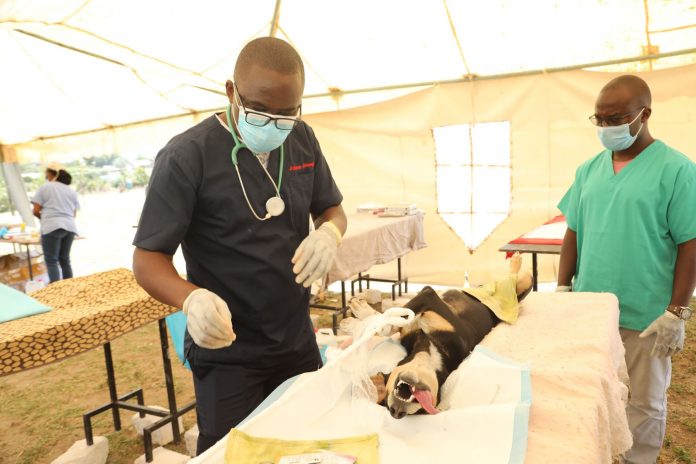In a bid to eradicate rabies by the year 2030, the national government has rolled out a mass vaccination drive of livestock.
According to Chief Administrative Secretary Agriculture Livestock Fisheries and Blue Economy Lawrence Emuhaka, currently, the Kenya Veterinary Association (KVA) program led is in Kilifi County with over 10,000 vaccines.
Addressing the media in Malindi during the KVA program launch, Mr. Emuhaka said 8,000 vaccines were donated by the government and the county donated 2,000 vaccines.
During the ongoing program, he said they did surgeries on animals, vaccinated them against rabies, deworming, and vaccinated them against lamb scale diseases.
“We are happy that the numbers have been big farmers have responded very and we are happy that this will have a big impact on our livestock and the economy of our country,” he said.
Mr Emuhaka said rabies disease is important because statistics show one person in the world dies due to rabies on an hourly basis which is a big number.
The strategic plan to eradicate rabies in the country is aimed at joining other African countries which are also in the process.
So far he said there are few countries that are rabies-free such as the UK and Anti arctic countries but the majority are still struggling to eradicate them.
“It’s difficult to treat rabies, if you are bitten by rabies you will spend close to Sh. 20,000 so prevention is better than cure that’s why we are doing vaccination for free. If we do that it will not cost much but if you wait to be bitten you will spend 20, 000,” he said.
The CAS said one dog alone can bite over 20 people.
Currently he said they are working with counties by supporting them with infrastructure, capacity building, and donation of vaccines to eradicate rabies completely.
He said they are working with Kenya Commercial Banks, Kenya Veterinary Association Cosmos which produces vaccines, government departments, US Aid and Fao.
“We are requesting for more people to come in so that we can be more effective and eradicate this disease by 2030 and am happy that we are on the right track,” he said.
Kilifi CEC Member for Agriculture, Livestock, and Fisheries Dr. Luciana Sanzua were happy to see the world rabies day being held in KIlifi County for the first time.
She said Kilifi County has few animals a reason why it has been difficult to sustain itself on milk and meat that is why they have been distributing livestock.
Dr Sanzua said last year there were 2,006 cases of rabies in Kilifi county which affects the economy due to the high costs of treatment.
Each year she said the county spends Sh. 15 million to treat rabies and thanked the cooperation with the KVA, Ministry of livestock.
“We allocate Sh3 million for a vaccine which reaches 2,000 animals despite the fact that we have 600,000 goats, 260,000 cattle, cats and others cannot be known. I however wish that this exercise go on so as to reach the whole population of animals to enable them be healthy,” she said.
The CEC said animal health was equivalent to human health as eating an unhealthy animal affects the health of people.
Each year she said they have two rounds of mass vaccination in Kilifi and farmers are aware of the programs targeting the areas with many livestock.
She said dogs and cats give birth to a lot of children which end up becoming a nuisance to the community.
Also Read:
- Prison Boss Calls For Speedy Arrest Of Nanyuki Fugitives
- Man Escapes With Gunshot Wounds After Botched Robbery
- Kenyans To Pay More For Milk, Sugar
“I urge all those people to ensure they take their cats and dogs for vaccination so as to reduce the rise in birth rate,” he said.
Kenya Tsetse and Trypanosomiasis Eradication Council (KENTTEC) Chief Executive officer Dr. Pamela Olet said they normally advise, coordinate, set standards for a specific sector or a particular disease and the vector that transmit the disease.
She said they coordinate different stakeholders and advise on the technology which can be used to eradicate a particular disease.
In Africa, she said there are 38 counties affected by testse while in Kenya 38 counties are tsetse infested.
“The level of infestation differs but I can tell you that where we are, the coastal belt is heavily infested which is one of the major causes of poverty in this area,’ she said.
Otit said areas like Kwale has very good grass but there are no animals because of the infestation of tsetse fly as drugs are expensive and farmers cannot afford to treat their animals.
She called on all government arms, national, community, and county government, private sector to come together and address the problem.
Joana Cheptoo the regional coordinator KENTTEC Coast region said all the six counties in the region are infested by tsetse fly and the state is not good.
Currently, he said they are starting intervention in Taita Taveta followed by Galana,
There is a lot to be done about tsetse fly infestation in these counties,” he said.
